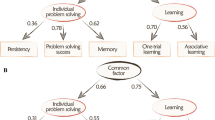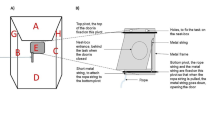Summary
Many dogs are found to be unsuitable for training as guide dogs for the blind. Consequently the Royal Guide Dogs for the Blind Association of Australia has embarked on a breeding program to produce a strain of labrador dogs which is suitable for guide dog training.
The most common reasons for rejecting dogs are fearfulness, dog distraction, excitability, health and physical reasons and hip dysplasia. The selection program seems to have been successful in improving the success rate mainly by lowering fearfulness, but there has not been a continuing improvement. This is probably due to continual introduction of dogs from other populations into the breeding program.
Males suffer from a higher rejection rate due to dog distraction and a lower rejection rate due to fearfulness and excitability than females, so that there is little sex difference in overall success rate.
The heritability of success (0.44) is high enough to predict further progress from selection, again mainly against fearfulness.
Variation in environment prior to 6 weeks of age, in age when dogs were placed into a private home and in age when males were castrated, had little effect on the success rate.
Similar content being viewed by others
Literature
Badham, B. (1975): The effect of artificial breeding on the rate of genetic improvement of butterfat yield in Victorian Jerseys. MSc thesis. Univers. Melbourne
Baillie, J.R. (1972): The behavioural requirements necessary for auide dogs for the blind in the United Kingdom. Br. Vet J. 128, 477
Biship, Y.M.M.; Fienberg, S.E.; Holland, P.W. (1975): Discrete Multivariate Analysis: Theory and Practice. Cambridge: MIT press
Ehrman, L.; Parsons, P.A. (1976): The Genetics of Behaviour. Sunderland: Sinaver
Elston, R.C. (1977): Estimating ‘heritability’ of a dichotomous trait. Biometrics 33, 232–236
Goddard, M.E. (1979): Development of a breeding programme for guide dogs. PhD thesis. Univers. Melbourne
Guide Dogs for the Blind (1975): Annual report. Guide dogs for the Blind. U.K.
Harvey, W.R. (1968): Instructions for Use of LSMLGP (leastsquares and maximum likelihood general purpose program). Unpubl. manual
Murphee, O.D.: Dykman, R.A. (1965): Litter patterns in the offspring of nervous and stable does. I: Behavioural tests. J. Nerv. Ment. Dis. 141, 321–322
Murphee, O.D.; Newton, J.E.O. (1971): Crossbreeding and special handling of genetically nervous dogs. Cond. Reflex 6, 129–136
Nelder, J.A. (1975): The GLIM System (generalized linear interactive modelling) Manual. Release 2 Roy. Stat. Soc.
Pfaffenberger, C.J.: Scott, J.P. (1959): The relationship between delayed socialization and trainability in guide dogs. J. Genet. Psychol. 95, 145–155
Scott, J.P.: Bielfelt, S.W. (1976): Analysis of the puppy testing program. In: Guide Dogs for the Blind: Their Selection. Development and Training (eds. Pfaffenbergcr, C.J.: Scott, J.P.: Fuller, J.L.; Ginsburg, B.E.; Bielfelt, S.W.). pp. 39–76 Amsterdam: Elsevier
Scott, J.P.; Fuller, J.L. (1965): Genetics and Social Behaviour of the Dog. Chicago: Univers. Chicago Press
Swiger, L.A.: Harvey, W.R.; Everson, D.O.: Gregory, K.E. (1964): The variance of intraclass correlation involving groups with one observation. Biometrics 20, 818–826
Tallis, G.M. (1959): Sampling errors of genetic correlation coefficients calculated from analyses of variance and covariance. Austr. J. Stat. 1, 35–43
Author information
Authors and Affiliations
Additional information
Communicated by J.S.F. Barker
Rights and permissions
About this article
Cite this article
Goddard, M.E., Beilharz, R.G. Genetic and environmental factors affecting the suitability of dogs as Guide Dogs for the Blind. Theoret. Appl. Genetics 62, 97–102 (1982). https://doi.org/10.1007/BF00293339
Received:
Issue Date:
DOI: https://doi.org/10.1007/BF00293339




